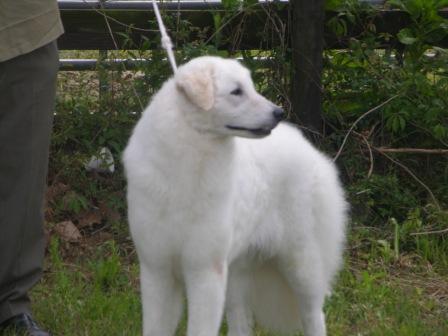Kuvasz Health
Like all other giant breeds, the rapid growth and large size can predispose Kuvasz to structural problems. Although the Kuvasz is one of the healthiest breeds you will encounter, there are some terms to be familiar:
HD: canine hip dysplasi is a polygenetic inherited disease that is assessed radiographically. It is the primary inherited problem in the breed and the one breeders are the most concerned with. Most Kuvasz are not clinical even if radiographically they are dysplastic. If a Kuvasz is limping, etc. it is wise to suspect another cause other than HD. Proper positioning is crucial for correct diagnosis of HD; therefore, it is important to have your dog x-rayed by an experienced vet. Only a dog with DJD (degenerative joint disease) or actual bone changes should be categorized as dysplastic. Subluxations is commonly seen in young Kuvasz and should not be misinterpreted as HD. Properly positioned radiographs should be evaluated by either OFA (Orthopedic Foundation for Animals) or the OVC (Ontario Veterinary College). All Kuvasz used for breeding should ahve been evaluated to have normal hips. The more savvy buyer will want to know about generations of normal hips and ideally siblings and offspring who are clear too.
ACL: anterior cruciate ligament injury is the most common cause of hind leg lameness in the Kuvasz. Classic signs are holding up of the affected leg, marginal improvement in subsequent days to toe touching to the ground, followed by the dog sitting with the affected leg to the side. If not corrected by surgery, arthritis will occur resulting in permanent damage/pain.
OCD: osteochondritis disscans is a common, painful disease in dogs. It is characterized by an abnormality in the cartilage-to-bone transformation. As a result, cartilage and bone fragments may break off into the joing space. OCD is not a form of arthritis, however, it often leads to arthritis. Larger breeds have a genetic predisposition towards the condition, which results from rapid growth. Areas most commonly affected by OCD include the shoulder, elbow, knee (stifle) and ankle (hock) in young dogs. Surgery is often the required course of treatment, but if it is, the prognosis for a complete recovery is very good.
GDV: gastric dilation volvulus aka "bloat" is a condition that is rapidly fatal in dogs, causing shock, coma, and death within 6-12 hours. It is characterized by stomach enlargement due to extreme gas or dilation. Dilation may be followed by "volvulus", a twisting rotation of the stomach (torsion). This closes both the esophagus and pylorus preventing the dog's stomach from relieving gas by belching; it also blocks the food from advancing into the intestinges and stops the suffering dog from getting rid of the food by vomiting. Bloat is always an emergency; so, you will need to get your dog to the vet as quickly as possible for treatment. Some veterinarians recommend, and some owners request, prophylactic gastropexy surgery to anchor the stomach in place before torsion occurs. This does not prevent the dog from bloating, but it does prevent the torsion.
HOD: hypertrophic osteodystrophy causes lameness and extreme pain in young growing dogs. It is believed to be the result of a vaccine reaction coupled with rapid growth. It manifests itself as acute lameness, dogs may stand "hunched up" and refuse to eat. There is often a fever, sometimes exceeding 105, with painful swellings of the lower joints of the legs. Some dogs will die as a result of the inflammation, some will suffer permanent disfigurement, but others will recover. Some owners will elect to euthanize a dog with HOD rather than watch it suffer. Treatment involves anti-inflammatory drugs (aspirin, Rimadyl, or prednisone) and time (up to six months in some cases). Diagnosis is made through radiographs or experienced breeder consult.
PANO: panosteitis is also known as growing pains. Like HOD, it is believed to be the result of a vaccine reaction and also involves inflammation. Typically, there is no long tern disfigurement of the joints however. Dogs with pano will often "scream" in pain, and the pain seems to migrate from leg to leg. Improvement is often cyclical with the dog showing periods of improvement followed by a relapse. Treatment involves anti-inflammatories such as aspirin in mild cases, Rimadyl or prednisone in more severe situations. Diagnosis is typically done through radiographs or experienced breeder consult. Complete recovery is likely.
PRA: progressive retinal atrophy refers to a group of diseases that cause the retina of the eye to degenerate slowly over time. The result is declining vision and eventual blindness. Prcd stands for progressive rod-cone degeneration which is a type of PRA known in several breeds. This genetic disorder causes rod and cone cells in the retina at the back of the eye to degenerate and die, even though the cells seem to develop normally early in life. The rod cells operate in low light levels and are the first to lose normal function. This results in night blindness. Then the cone cells gradually lose their normal function in full light situations. Most affected dogs will eventually be blind. Typically, the clinical disease is recognized first in early adolescence or early adulthood.
